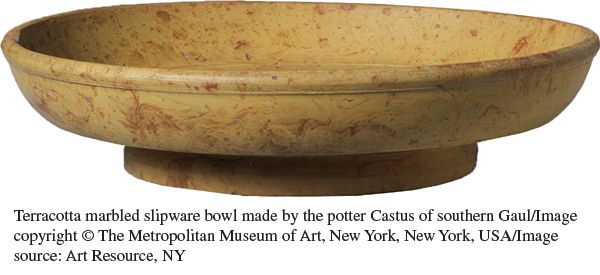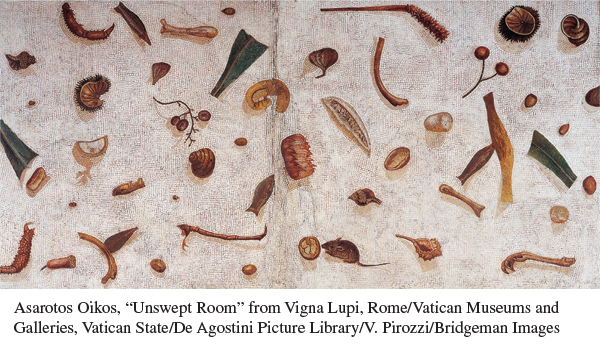Living in the Past: Roman Table Manners
138
Roman Table Manners
U ntil the late republic most Romans, rich and poor, ate the same plain meals of bread, olives, vegetables, and a little meat or fish, with fruit for dessert. They used fingers and wooden spoons to serve themselves from simple pottery or wooden bowls and plates. They usually drank water or wine mixed with water from clay cups. Drinking unmixed wine was considered a sign of degeneracy. The Romans took three meals a day: an early breakfast, a main meal or dinner in the middle of the day, and a light supper in the evening. Dinner was also a social event, the main time for Romans to visit, chat, and exchange news. Afterward everyone who could afford the time took a long nap, especially during the hot summer months.



The conquest of the Mediterranean world and the spread of Hellenism changed Roman table manners. As many urban dwellers grew richer and more sophisticated, they began to dine more elegantly. By the late republic and early empire, Romans dined formally on couches around a circular table. Tableware became more varied and refined. Metal spoons took the place of wooden ones, and silver and bronze platters took the place of pottery. In the early first century B.C.E. artisans in Syria developed glassblowing, a technique they took to Rome when Syria was conquered by the Romans in 64 B.C.E. Glassblowing revolutionized glass production, and glass drinking cups could soon be seen on nearly every Roman table. Dinner was now served in three courses. It began with an appetizer, ordinarily composed of vegetables and eggs. Next came the main course of young goat, chicken, pork, or fish, which was followed by a dessert of fruit, including new varieties from the provinces.
139
For the richest Romans, dinners consisted of many courses of exotic dishes such as the livers of rare fish, the brains and tongues of flamingos and pheasants mixed in sauce, and seafood of every description. The more outlandish the dish, the more the wealthy Romans appreciated it. Nuts and berries completed the meal, which the Romans washed down with vintage wines drawn from all over the empire. All of the scraps ended up on the floor.
QUESTIONS FOR ANALYSIS
- What social purposes did the elaborate meals of wealthy Romans in the late republic serve?
- How are changes in Roman eating habits, as described here and reflected in the two pieces of tableware, symptomatic of social and cultural changes in the late republic? What do you imagine Cato the Elder would have said about the fancy glass and the mosaic floor?